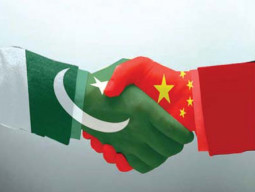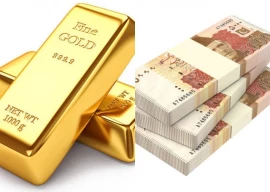
Almost all economic turnarounds in the recent past have primarily been exports-led. From China to India, a rising share of exports as a fraction of the gross domestic product (GDP) has been a key feature of every economic success story in recent decades.
But global trade data suggests Pakistan fares poorly compared to regional economies when it comes to the competitiveness of its exports in the international market.
The gap appears starker when the growth rate of Pakistan’s exports is compared with that of India.

According to the World Trade Organization (WTO), Pakistan’s exports grew at an average rate of 7.7% per annum between 2003 and 2013. In contrast, the annual increase in the value of India’s exports during the same 10-year period remained 18.9%.
According to economist Atif Mian, the performance of India and Pakistan looked fairly similar until 1992. But data from 1992 onwards shows a great divergence between the two countries in terms of their exports’ competitiveness, he added.
“Since 1993, Indian and Bangladeshi exports per capita have grown 5.8 and 3.8 times higher than that of Pakistan, respectively. These are enormous differences in growth,” Mian told The Express Tribune in an interview.
The International Monetary Fund (IMF) has recently named Mian, professor of economics at Princeton University, among 25 economists under 45 ‘who are shaping the way we think about the global economy’.

“If Pakistan continues to fall behind at such a pace for another generation, my fear is that it might become a regional economic ghetto. The government needs to wake up,” he noted.
Sound institutions
Many people argue that the widening difference in the exports per capita of India and Pakistan is a direct consequence of the economic liberalisation programme that India went through post-1992 under former finance minister Manmohan Singh.
But Mian believes this explanation is flawed. He says Pakistan had a more liberalised economy – and much earlier – than India. However, Pakistan’s exports per capita never saw that kind of a sudden increase, he adds.
In fact, Pakistan’s exports as a percentage of its GDP used to be higher than that of India. But the opposite is now true, with India’s exports as a fraction of its GDP far exceeding that of Pakistan.
Moreover, Pakistan’s exports as a fraction of the GDP tend to go down over time despite the fact that there has been a massive expansion in global trade in the last 20 years.
Mian believes boosting domestic productive capacity is the biggest challenge that Pakistan is facing today. Low exports mean the economy is struggling to produce products that are competitive in the global market, he says.
And the reason for Pakistan’s inability to compete in international trade is its lack of sound institutions, he says. “Just like individuals cannot grow and prosper without a good work ethic, countries cannot grow without good institutional foundations,” he noted.
The writer is a staff correspondent
Published in The Express Tribune, September 15th, 2014.
Like Business on Facebook, follow @TribuneBiz on Twitter to stay informed and join in the conversation.
COMMENTS (14)
Comments are moderated and generally will be posted if they are on-topic and not abusive.
For more information, please see our Comments FAQ

















@Vinsin: Why do we have to be so unsocial on social pages with each other? Regards.
Other than textiles (which is highly competitive) what does Pakistan produce that the World wants/needs? You want to expand exports then you need to attract foreign investment to build the mfg facilities for products in demand - and that's going to require that you address issues like xenophobia, security, justice and otherwise revamp your international image.
Comparing Pakistan with any other nation to show how we are falling behind is not the best way to portray Pakistan. The comparison should be reasonable and may be we should compare ourselves with Bangladesh, Afghanistan, Iran, Uzbekistan, Turkey, etc.
Comparing ourselves with either India or China because we share a border with them or we have an axe to grind does not help our next generation.
By the way for those who may not know what else Pakistan exports...Mangoes among other fruits which I am sure our eastern neighbors would want to know.
Apart from food items clothes and terrorism I don't know what pakistani can export.
@Green Sword Good for you, keep selling Rice, towels & Bed-sheets
@Keshav joshi: please blow yourself up.... ??? :O isn't that what pakistanis are good at ,,, :D \m/
I distinctly remember the 70s where Pakistan was apparently being labelled as the next Asian tiger in the making and India's growth rate was derisively referred to as the 'Hindu rate of growth' by the west. Back then, an average Pakistani was relatively much better off than the average Indian.
Back then we only had Fiat padminis and Ambassadors on our streets whereas they had Corollas, Camrys and Buicks on their streets.
Lo! How things have changed. I remember my Pakistani neighbor in Dubai always referring to the miskeen (poor) indians (and this was the 80s). I wish I could meet that guy today. We'd revive some good memories and have a good chatter.
"Here in Australia Pakistani rice is most liked and no one buys one grain of indian rice."
May I direct you to your own Country's article http://tribune.com.pk/story/753053/rice-industry-lack-of-branding-hurts-pakistan-india-moves-ahead/
And I case you think that brands like Rivianna and LarPak are Pakistani brands then please blow yourself up...
"Here in Australia Pakistani rice is most liked and no one buys one grain of indian rice."
May I direct you to your own country's article http://tribune.com.pk/story/753053/rice-industry-lack-of-branding-hurts-pakistan-india-moves-ahead/
And in case you think that brands like Rivianna and LarPak are Pakistani brands then please blow yourself up...
One country focuses on modernizing its population and workforce by embracing ideas from all over the world, liberalism, free markets, opening its country to foreign investment, ridding itself of superstitious dogma and continuously questioning and challenging the existing status quo while another still holds on to the past, causes endless trouble to its neighbors and refuses to move on from a puritanical interpretation of a beautiful faith. No one should be surprised of the divergent paths that the two countries have embarked upon and unless Pakistanis take responsibility for the quagmire of a situation they are in, it may well be on a path towards becoming the next Somalia of Asia.
the causal mechanism of how exports have suffered is in the article on your pages right here: http://tribune.com.pk/story/762213/business-stories-the-rise-and-fall-of-the-chenab-group/
False propaganda by IMF stooge. Here in Australia Pakistani rice is most liked and no one buys one grain of indian rice.
It is time Pak stops comparing itself with India, be it economics or military strength. I dont think it will provide a good picture. The correct basis for comparison might be with B'desh as it is similar in size.
"But Mian believes this explanation is flawed. He says Pakistan had a more liberalised economy – and much earlier – than India."
This statement is 100% correct. Pakistan has least number of controls/restrictions on FDI. It is actually a kind of paradise on earth for investors. Still, not many want to invest in Pakistan. Probably, alarming security situation and poor infra (which seems to be worse than even India) are the reasons.